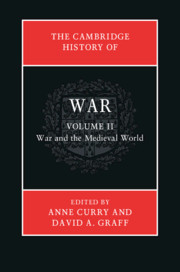Book contents
- The Cambridge History of War
- The Cambridge History of War
- Copyright page
- Contents
- Illustrations
- Maps
- Notes on contributors
- Introduction to volume II
- Part I Foundations, c.600–1000 ce
- Part II Interactions, c.1000–1300 ce
- Part III Nations and Formations, c.1300–1500 ce
- 13 Western Europe, 1300–1500
- 14 Warfare and Italian states, 1300–1500
- 15 The reconquest and the Spanish monarchies
- 16 The Byzantine empire and the Balkans, 1204–1453
- 17 Ottoman expansion and military power, 1300–1453
- 18 India, c.1200–c.1500
- 19 Southeast Asia, 1300–1540
- 20 Japan, 1200–1550
- 21 The Americas
- Part IV Comparisons: Cross-Cultural Analysis
- Select bibliography
- Index
21 - The Americas
from Part III - Nations and Formations, c.1300–1500 ce
Published online by Cambridge University Press: 25 September 2020
- The Cambridge History of War
- The Cambridge History of War
- Copyright page
- Contents
- Illustrations
- Maps
- Notes on contributors
- Introduction to volume II
- Part I Foundations, c.600–1000 ce
- Part II Interactions, c.1000–1300 ce
- Part III Nations and Formations, c.1300–1500 ce
- 13 Western Europe, 1300–1500
- 14 Warfare and Italian states, 1300–1500
- 15 The reconquest and the Spanish monarchies
- 16 The Byzantine empire and the Balkans, 1204–1453
- 17 Ottoman expansion and military power, 1300–1453
- 18 India, c.1200–c.1500
- 19 Southeast Asia, 1300–1540
- 20 Japan, 1200–1550
- 21 The Americas
- Part IV Comparisons: Cross-Cultural Analysis
- Select bibliography
- Index
Summary
The Americas constitute one of the most topographically diverse and environmentally heterogeneous regions of the world, and each of these dimensions, and a host of social, economic, political, and cultural variables, necessarily serve to define the nature of war and society in the American hemisphere. In the two centuries anticipating Columbian contact with the New World in 1492, the Americas were largely dominated by the rise and fall of hundreds of kingdoms and warring polities, and the emergence of two powerful, albeit militaristically distinctive, imperial traditions – one Mesoamerican, the other Peruvian. Each evolved from a pattern of military statecraft and conquest interaction that coalesced in the highlands of each region in the period extending from 1300 to 1500 ce. While the Andean highlands of Peru and Bolivia were the crucibles of a centuries-old tradition of empire building, questions regarding the extent to which Mesoamerican empires fully and completely consolidated their gains as hegemonic imperial formations remain.
- Type
- Chapter
- Information
- The Cambridge History of War , pp. 554 - 612Publisher: Cambridge University PressPrint publication year: 2020

